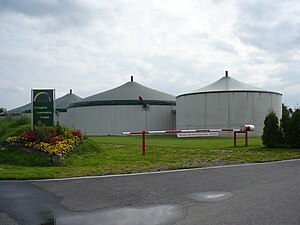 |
| Image via Wikipedia |
The main problem with anaerobic digestion
of crop residues is that most of the agricultural residues are
lignocellulosic with low nitrogen content. To improve the digestibility
of crop residues, pre-treatment methods like size reduction, electron
irradiation, heat treatment, enzymatic action etc are necessary. For
optimizing the C/N ratio of agricultural residues, co-digestion with
sewage sludge, animal manure or poultry litter is recommended.
Several organic wastes from plants and
animals have been exploited for biogas production as reported in the
literature. Plant materials include agricultural crops such as sugar
cane, cassava, corn etc, agricultural residues like rice straw, cassava
rhizome, corn cobs etc, wood and wood residues (saw dust, pulp wastes,
and paper mill. Others include molasses and bagasse from sugar
refineries, waste streams such as rice husk from rice mills and residues
from palm oil extraction and municipal solid wastes, etc. However,
plant materials such as crop residues are more difficult to digest than
animal wastes (manures) because of difficulty in achieving hydrolysis of
cellulosic and lignocellulosic constituents.
Crop residues can be digested either
alone or in co-digestion with other materials, employing either wet or
dry processes. In the agricultural sector one possible solution to
processing crop biomass is co-digestion together with animal manures,
the largest agricultural waste stream. In addition to the production of
renewable energy, controlled anaerobic digestion of animal manures
reduces emissions of greenhouse gases, nitrogen and odour from manure
management, and intensifies the recycling of nutrients within
agriculture.
In co-digestion of plant material and
manures, manures provide buffering capacity and a wide range of
nutrients, while the addition of plant material with high carbon content
balances the carbon to nitrogen (C/N) ratio of the feedstock, thereby
decreasing the risk of ammonia inhibition. The gas production per
digester volume can be increased by operating the digesters at a higher
solids concentration. Batch high solids reactors, characterized by lower
investment costs than those of continuously fed processes, but with
comparable operational costs, are currently applied in the agricultural
sector to a limited extent.
